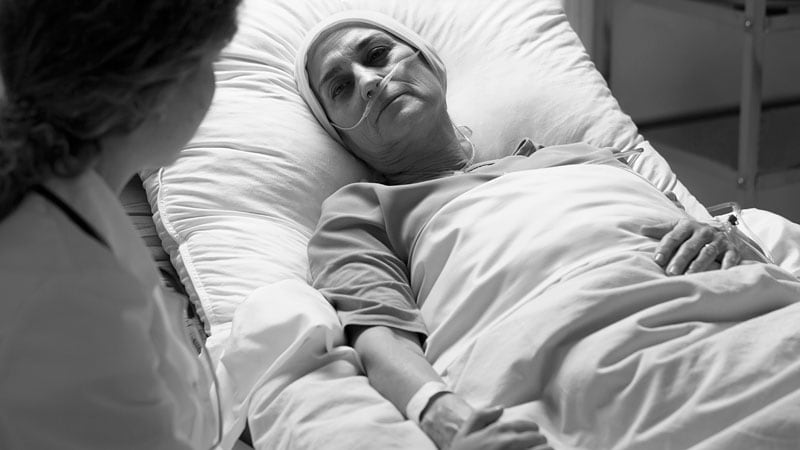Aggressive cancer care at the end of life is still common. A new study shows that such care is slightly more likely among patients with metastatic cancer who live in nursing homes than among those who live in the community, although use among both groups is high. The findings suggest that recent messaging about less intensive treatment at the end of life is not getting through, say researchers reporting the findings.
The study was published online on February 22 in JAMA Network Open.
The investigators gathered information from three databases on more than 146,000 older patients with metastatic breast, colorectal, lung, pancreatic, or prostate cancer.
They found that 63.6% of patients who lived in nursing homes had received aggressive end-of-life care, compared to 58.3% of those who lived in the community.
However, patients with metastatic cancer who lived in nursing homes were 61% more likely to die in hospital and were 43% less likely to receive cancer-directed care in comparison to those living in the community.
“Despite the increased emphasis on reducing aggressive end-of-life care, such care remains highly prevalent among older persons with metastatic cancer and is more common among nursing home residents than their community-dwelling counterparts,” said lead author Siran M. Koroukian, PhD, from the Department of Population and Quantitative Health Sciences, Case Western Reserve University School of Medicine, Cleveland, Ohio.
The use of aggressive disease-oriented interventions at the end of life is associated with increased symptom burden, frequent emergency department visits, as well as stays in hospital and in intensive care units. It is also linked to delays in accessing hospice programs and “enormous personal and financial costs,” the authors point out.
“Interventions to decrease aggressive EOL [end-of-life] care should target the main factors associated with its prevalence, including hospital admissions in the last 6 months of life and in-hospital death,” Koroukian commented.
Treatment in Nursing Homes Is “Complicated”
In the United States, around 1.5 million individuals currently live in nursing homes, and approximately 10% of them have been or will be diagnosed with cancer.
Their treatment is “complicated…[by their] high morbidity burden, functional dependency, and/or cognitive impairment.” In addition, many will experience treatment-related adverse events, the authors comment.
While it is known that aggressive end-of-life care “remains common among community-dwelling patients with cancer, little is known about such patterns of care among nursing home residents,” the researchers say.
To investigate further, they used the Surveillance, Epidemiology, and End Results (SEER) database, Medicare enrollment and claims data, and the Minimum Data Set, which includes nursing home clinical assessment data, for July 1, 2012, to December 31, 2017.
Deaths during the calendar years 2013 to 2017 were evaluated. The 6-month look-back period allowed the investigators to determine comorbid conditions, treatments received, and other health services utilization before death.
The team identified 146,329 adults with active metastatic breast, colorectal, lung, pancreatic, or prostate cancer. The patients were aged at least 66 years at diagnosis. The mean age of the patients was 78.2 years, and 28.0% were nursing home residents.
Nursing home residents were similar to those living in the community with respect to sex, race, and ethnicity, although those in nursing homes were slightly older and were slightly more likely to be women and non-Hispanic Black patients.
The percentage of patients who were eligible for Medicare and Medicaid was higher among nursing home residents than among community dwellers, at 30.4% vs 17.1%, and the proportion of patients with at least five comorbid conditions was far higher among residents, at 75.5% vs 48.8%.
The team found that aggressive end-of-life care was 4% more likely for patients living in nursing homes, although the rates varied by patient demographics, cancer type, and number of comorbid conditions, among other characteristics.
Multivariate analysis indicated that, after adjustments, residing in a nursing home was associated with a significant increase in the likelihood of receiving aggressive end-of-life care (odds ratio [OR], 1.04). Nursing home residents were also significantly more likely to have more than one hospital admission in the last 30 days of life (OR, 1.06) and of dying in the hospital (OR, 1.61).
On the other hand, nursing home residents were significantly less likely than community dwellers to receive cancer-directed treatment (OR, 0.57), to be admitted to an intensive care unit (OR, 0.82), or to be enrolled in a hospice in the last 3 days of life (OR, 0.89).
The researchers caution, however, that “it was not possible to describe the circumstances surrounding receipt of aggressive end-of-life care and whether care decisions were made in accordance with the patient’s preferences.
“Nonetheless, the fact that receipt of cancer-directed treatment was lower among NH [nursing home] residents than among their community-dwelling counterparts reflects a decision — whether by the patient or proxies and/or health care professional — to decrease care.
“However, the reasons why such a decision was not coupled with early enrollment in hospice remain unaddressed,” the researchers say.
The study was supported by a grant from the National Cancer Institute. Koroukian received a subcontract from Celgene Corporation outside the submitted work. Other authors reported numerous relationships with industry.
JAMA Netw Open. Published online February 22, 2023. Full text
For more news, follow Medscape on Facebook, Twitter, Instagram, and YouTube.
Source: Read Full Article
